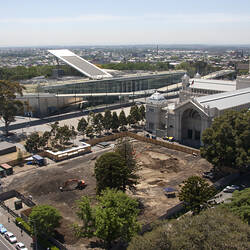Physical Description
Two complete wire iron alloy nails that appear to have rose heads although rust and encrustation make identification difficult. Manufacturing period is from the 1850s.
Physical Description
Two complete wire iron alloy nails that appear to have rose heads although rust and encrustation make identification difficult. Manufacturing period is from the 1850s.
More Information
-
Collection Names
-
Collecting Areas
Public Life & Institutions, Historical Archaeology, Royal Exhibition Building
-
Acquisition Information
Transfer from Godden Mackay Logan Heritage Consultants (GML), Department of Archaeology, La Trobe University, Australia Gallery, History & Technology Department, Museum Victoria, 20 Nov 2009
-
Manufacture Date
-
Context Number
G13/H13/Baulk 3/4/168
-
Site
Australia, Victoria, Melbourne, Royal Exhibition Building Western Forecourt
-
Activity
-
Specific Activity
-
Technique
-
Classification
-
Category
-
Discipline
-
Type of item
-
References
Poplar Forest 1996: 38; Miller et al 2000: 14; Varman 1980: 107-108
[Book] 1996. Poplar Forest Archaeology Lab and Field Manual., 1996, 38 Pages
[Article - Journal] Miller, George L., et al. Telling Time for Archaeologists. Newsletter of the Council for Northeast Historical Archaeology. 29: 1-22., 2000, 14 Pages
[Article] Varman, Robert. 1980. The Nail as a Criterion for the Dating of Building and Building Sites (Late 18th Century to 1900), in Birmingham, Judy & Bairstow, Damaris. 1980. Papers in Australian Historical Archaeology. 104-112., 1980, 107-108 Pages
-
Keywords
Archaeology, Building Materials, Royal Exhibition Building, World Heritage

